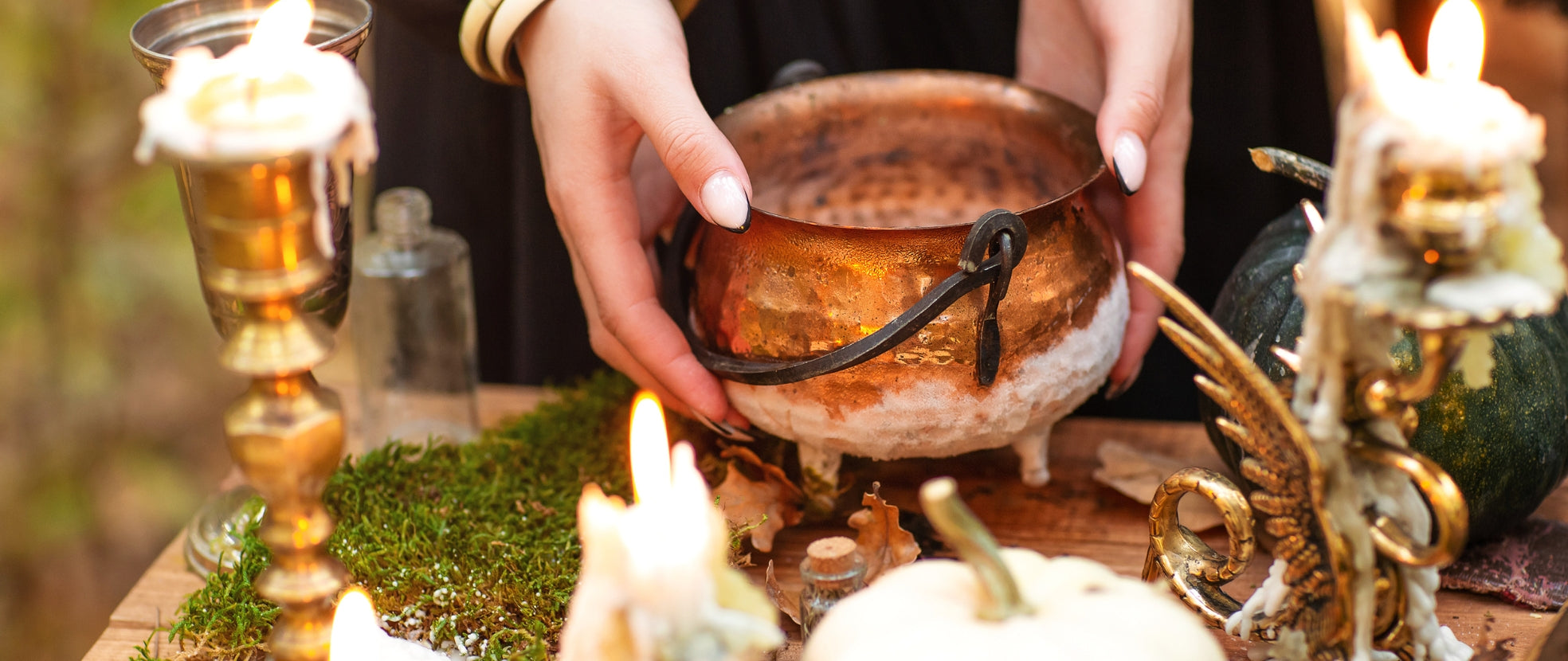As October's chill sets in and the nights grow longer, anticipation for Halloween sweeps through the western world. Ghostly decorations, pumpkin-carved smiles, and whispers of witches become commonplace, symbolizing a cultural ritual deeply embedded in our society.
However, while Halloween may be a hallmark of the West, it is not the only festival of the supernatural during this season. Across the globe, cultures come alive with their own unique celebrations, revering the mysteries of the dead, spirits, and the supernatural. Journey with us as we delve into the tapestry of traditions that mark this spine-tingling time of year, and discover the myriad ways different cultures honor the eerie and ethereal.

What even is Halloween?
In Western culture, we celebrate Halloween on October 31st. It is a time-honored tradition with roots dating back to ancient Celtic festivals. Originally known as "Samhain", it marked the end of the harvest season and was believed to be a time when the boundary between our world and the spirit realm blurred, allowing spirits and fairies to walk the earth. Over time, Christian influences merged with these pagan customs, leading to the creation of "All Hallows' Eve", the night before All Saints' Day.
Today, Halloween has evolved into a festive and largely secular holiday characterized by costumes, jack-o'-lanterns, trick-or-treating, haunted attractions, and parties. Children and adults alike dress up as anything from witches to superheroes, venturing out into the night in pursuit of candy or a good fright. In essence, Halloween serves as a unique blend of ancient rituals and modern revelry, providing a yearly outlet for imagination, celebration, and just a touch of the supernatural.

Samhain: The Celtic Influence from Ireland
Samhain (pronounced "sow-in"), originating from the ancient Celtic festival, marks the end of the harvest season and the onset of winter. Traditionally celebrated from the evening of October 31st to the evening of November 1st, it is a time when the boundary between the worlds of the living and the dead is believed to be at its thinnest, allowing spirits to pass through.
In ancient Ireland, it was a significant event – fires were lit to ward off evil spirits, and rituals were performed to honor the deceased and ensure a prosperous year ahead. Over time, the traditions associated with Samhain have evolved, and its influence can be clearly seen in modern Irish culture. Most notably, it is the precursor to today's Halloween celebrations, with many customs such as carving pumpkins (originally turnips in Ireland) and donning costumes stemming from ancient Samhain practices.
Samhain's mysticism also spread across the British Isles and into other parts of Europe. As the Celts migrated and mingled with other cultures, their traditions merged with existing local customs.
In the British Isles, for instance, people would leave food and wine outside their homes, hoping to appease roaming spirits and ensure protection for the coming winter. Meanwhile, in parts of Northern Europe, similar festivals saw the lighting of bonfires and practices of divination, where young men and women would try to foretell their futures, especially regarding love and marriage.
This blend of cultures over the centuries further enriched the significance and observance of Samhain. Through the ages, Samhain has remained a testament to Ireland's rich cultural tapestry, bridging the past with the present.

All Saints' Day: A Christian holiday that's big in Spain
All Saints' Day, known as "Día de Todos los Santos" in Spanish, is a solemn Christian festival observed on November 1st to honor all the saints, known and unknown. This day is dedicated to remembering the deceased, especially those who have attained sainthood according to Christian belief.
Spain, with its rich Catholic heritage, observes All Saints' Day with great reverence and distinct cultural flair. Traditionally, Spanish families come together to visit cemeteries, bringing flowers and candles to decorate the graves of their loved ones. Special pastries, such as 'huesos de santo' (saint's bones) and 'buñuelos de viento' (wind fritters), become staple treats during this time.
In many regions of Spain, age-old customs related to All Saints' Day have evolved and blended seamlessly with the modern world. For instance, in the northern regions, locals enact 'Danzantes y Pecados' (Dancers and Sins), a theatrical performance that symbolizes the battle between good and evil.
While in other areas, children partake in a tradition resembling trick-or-treating, going door-to-door to ask for sweets or "soul-cakes" while reciting prayers or singing songs for the departed. These diverse traditions highlight the multifaceted ways in which Spain celebrates and honors the memory of saints and departed souls.
Moreover, it's not just a day of remembrance; it's also a reflection of Spain's deep-rooted faith and the merging of ancient traditions with religious observances. The streets echo with melancholic yet soulful music, and churches hold special masses, making the entire day a profound experience of spirituality and cultural immersion.

Día de Los Muertos: A Deep-Rooted Mexican Tradition
Día de Los Muertos, or Day of the Dead, is a vibrant and deeply significant celebration that takes place across Mexico between October 31st and November 2nd. While it might be easy to draw parallels with Halloween due to its proximity on the calendar, Día de Los Muertos stands distinct in its essence and symbolism.
Beyond its colorful façade lies profound symbolism. The marigolds, often referred to as the "flowers of the dead", are believed to attract the souls of the departed with their bright hues and aromatic scent.
Sugar skulls, with their intricate designs, serve as a sweet reminder of the fleeting nature of life, while the presence of favorite foods and beverages of the deceased signal their welcomed return during this brief window. It's a time when the boundaries between life and death blur, allowing for a spiritual reunion and celebration.
Rooted in a blend of indigenous Mesoamerican beliefs and Catholicism, the holiday is a time to honor and remember deceased loved ones, celebrating their lives rather than mourning their deaths. Families create elaborate altars, or "ofrendas", adorned with candles, marigolds, sugar skulls, and personal mementos, offering a bridge between the living and the dead. Food, music, and dance permeate the atmosphere, turning graveyards into lively gathering spaces.
Over time, the tradition has not only solidified its importance within Mexico but has also influenced art, cinema, and pop culture worldwide, making Día de Los Muertos a profound reminder to Mexico's rich culture and its embrace of life, death, and the cyclical nature of existence.
Dia das Bruxas: Portugal's twist on Halloween
"Dia das Bruxas," directly translated as "Day of the Witches," is Portugal's version of the widely celebrated Halloween. Rooted in ancient Celtic traditions that marked the end of the harvest season and the onset of winter, this day has evolved in its significance and festivities across cultures.
In Portugal, while it doesn't hold the same commercial pomp as in countries like the United States, "Dia das Bruxas" has been gradually gaining traction. Traditionally, Portuguese children have not gone trick-or-treating in costumes; instead, the emphasis has been on celebrating the day with family and remembering ancestors. However, the influence of global pop culture has ushered in a blend of old and new traditions.
The merging of traditions has given "Dia das Bruxas" a unique flavor in Portugal. In some regions, local folklore and legends come alive, adding an indigenous twist to the celebrations. Pão-por-Deus, a tradition that predates the concept of trick-or-treating, sees children going from door to door, singing songs and asking for treats or small gifts.
This practice, reminiscent of the times when people would give offerings for the souls in purgatory, is still observed in many villages. The fusion of these ancient customs with the modern symbols of Halloween creates a rich tapestry of celebration that is distinctly Portuguese.
Today, it's not uncommon to see carved pumpkins, themed parties, and children donning their favorite costumes roaming the streets in search of sweets. Nonetheless, the underlying theme in Portugal remains a mix of reverence for the past and a joyful embrace of the present.
Sint-Maarten: A Dutch Tradition of Light and Sharing
Sint-Maarten, celebrated on the 11th of November, is a cherished tradition in the Netherlands that marks the name day of Saint Martin of Tours.
Rooted in ancient European harvest celebrations, the festivity is particularly beloved by children who, when evening falls, venture out with brightly lit lanterns singing special Sint-Maarten songs. As they go door-to-door in neighborhoods, they are rewarded with sweets and treats, echoing the legend of Saint Martin, who was known for his kindness and generosity.
Saint Martin of Tours, the figure behind this delightful tradition, was a Roman soldier before becoming a monk. Legend has it that on a bitterly cold winter day, he came across a beggar with scant clothing. Moved by the beggar's plight, Saint Martin sliced his own military cloak in half and shared it with the man.
This act of compassion not only saved the beggar from the harsh cold but also marked a turning point in Saint Martin’s life, leading him towards his spiritual journey. His tale serves as a poignant reminder of the essence of the festival – the act of giving selflessly and caring for those less fortunate.
The event is not just an occasion for merriment but also embodies the Dutch values of sharing and community. Although Sint-Maarten is primarily observed in the northern provinces of the Netherlands, its heartwarming spirit resonates across the country, reminding everyone of the joy of giving and the importance of community bonds.
Fet Gede: A Deep Dive into Haiti's Day of the Dead
Fet Gede, often referred to as the "Festival of the Dead," is one of Haiti's most profound and significant spiritual celebrations. Rooted deeply in the Vodou tradition, it pays homage to the Gede spirits, who are the ancestral spirits of the dead.
These spirits are known for their wisdom, and they serve as intermediaries between the living and the divine. Embodied by the likes of Baron Samedi, the leader of the Gede spirits and the guardian of cemeteries, and his consort Maman Brigitte, these deities stand as vibrant symbols of life, death, resurrection, and healing.
The celebration of Fet Gede in Haiti is a spectacular blend of ritual, festivity, and reverence. Taking place annually around the beginning of November, it bears some resemblance to the Day of the Dead celebrations observed in other cultures. Devotees throng to cemeteries, cleaning graves, decorating them with candles, flowers, and other offerings, while Vodou priests (Houngans) and priestesses (Mambos) lead ceremonies to honor the Gede spirits.
The air is filled with the sounds of drumming, chanting, and singing, as participants often enter trances, allowing the spirits to communicate and provide guidance. The celebration serves as a vivid reminder of the cyclical nature of life and the eternal bond between the living and the departed.
Teng Chieh: The Lantern Festival in China
Teng Chieh, commonly known as the Lantern Festival, is one of the most enchanting and vibrant celebrations in China, marking the culmination of the two-week-long Chinese New Year festivities. Falling on the 15th day of the first lunar month, this festival coincides with the first full moon night of the Chinese calendar year.
A dazzling spectacle, Teng Chieh is renowned for its mesmerizing displays of intricately designed lanterns that illuminate the night sky. From traditional paper lanterns, portraying myths and legendary figures, to the more modernized designs with riddles on them, the beauty of this festival transcends mere aesthetics. It embodies the Chinese people's deep-rooted traditions, hopes for the future, and the reunion of family and friends.
The celebration of Teng Chieh is not just limited to the display of lanterns. Throughout the years, it has incorporated a multitude of cultural practices. Dragon and lion dances, as well as other performances, can be seen in the streets, bringing mirth and vigor to the festival.
Another beloved tradition during Teng Chieh is the consumption of "tangyuan" or sweet rice balls. These delicacies, often filled with sweet fillings like black sesame or red bean, symbolize unity and togetherness, epitomizing the very essence of the Lantern Festival. As families gather to witness the lanterns rise and share bowls of tangyuan, Teng Chieh becomes a poignant reminder of the importance of unity, family bonds, and the continuity of culture and tradition in the vast tapestry of China's history.
Japan has their own style of Halloween!
In Japan, Halloween has been transformed into a unique fusion of Western and Japanese customs. "Halloween" in its Western sense was not celebrated in Japan until a Disneyland celebration in 2000. Although not a native tradition, Halloween has grown in popularity over the past few decades, especially among the younger generation.
Major urban centers like Tokyo, Osaka, and Kyoto witness streets filled with people in costumes ranging from spooky to kawaii (cute). Shibuya crossing in Tokyo, in particular, is famed for its massive Halloween gatherings where thousands throng the streets in an eclectic mix of outfits. Many businesses, from cafes to department stores, join the festivities, offering Halloween-themed merchandise and treats.
Yet, while the revelry and costumes echo Western celebrations, Japan has its own spin on the festivities. One key distinction is the absence of trick-or-treating in the traditional Western sense. Instead, children often participate in Halloween events organized by schools or local communities. These events might include parades, costume contests, or themed games.
Additionally, Japan draws a connection between Halloween and its own ghostly traditions, such as the Obon festival – a Buddhist event honoring deceased ancestors. As such, some Japanese Halloween events might incorporate elements of these indigenous practices, blending the lines between the foreign and the familiar, creating a celebration that is distinctly Japanese.

Conclusion
As the curtain falls on our global journey of spectral celebrations, we find a common thread weaving through the tapestry of traditions: the eternal bond between the living and the departed.
From the lively streets of Tokyo to the serene lantern-lit skies of China, from the profound Vodou ceremonies in Haiti to the spirited parades of Mexico, each culture, in its unique way, honors the mysteries of existence, the cyclical nature of life, and the profound connections that transcend the mortal realm.
These celebrations, whether steeped in ancient rites or newly adopted traditions, serve as yearly reminders of our shared human experience. They urge us to cherish moments, remember our ancestors, and embrace the ever-present dance between the tangible and the ethereal.
As the cold of October deepens and the world prepares for winter's embrace, may we all find solace, joy, and wonder in the myriad ways we remember, celebrate, and honor the spirits among and within us.





